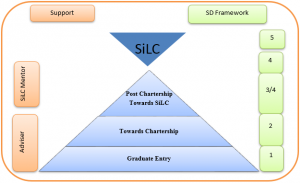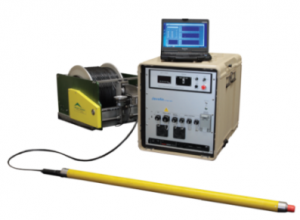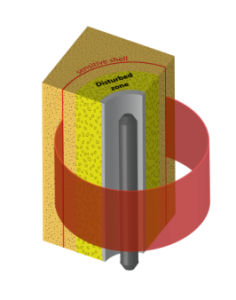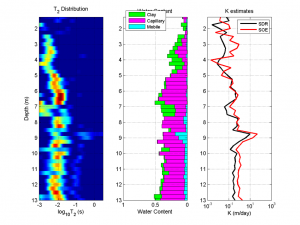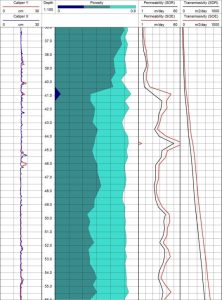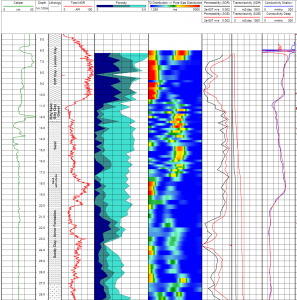The safety moment from Network Rail below describes discusses a worker who fell a short way down embankment and lacerated his leg on top hat cover.
AGS Digital Data – Why is it so Difficult to Get?
- byAn opinion piece, written by Chris Raison, Director of Raison Foster Associates
AGS digital data is the source data for most ground investigations. It allows rapid and accurate passing of information through the entire construction team, from the Site Investigation and Laboratory Testing Contractor, to the ultimate user of the data; the Engineer, Main Contractor or Specialist Contractors. As an ideal, AGS data removes the need for users to re-enter data for use in the design. It increases accuracy by avoiding typos and data translation errors, and it speeds up review and assessment of the data. It provides the full data set to all subsequent users and avoids the filtering and random selection that hardcopy data can be subject to. But is it actually achieving these benefits across the construction industry? Why is it so often difficult to obtain? Why isn’t AGS data being universally used on all projects, from big to small? What can the AGS do about this? Does the AGS actually recognise that there is a problem?
Part of the problem is viewpoint
Most Site Investigation and Laboratory Testing Contractors record and store their data using software and data processing that is compatible with and generates AGS data. Borehole logs, laboratory presentation plots, report tables and figures are all generated from their AGS data. From their perspective, the data is available and is used. It is what happens next that controls availability to others.
Large Consulting Structural and Civil Engineer organisations do recognise the value of AGS data for all sizes of project. Scope of works and specifications for ground investigations will include requirements for the GI Contractors to provide AGS digital data together with their final GI reports [GIR]. They will usually offer and provide the AGS data to the Main and Specialist Contractors working on their projects. From their viewpoint, ‘AGS data is working ‘. ‘Why worry about it ‘?
But are these viewpoints acceptable? Is this the universal experience with AGS data? I would suggest this is not the case.
Many organisations approximately follow the 80:20 rule. It is probable that 80% of geotechnical design in terms of value is being carried out by 20% of the Engineering Consultants, the larger companies already using and valuing AGS data. So, no problem here.
Conversely, the remaining 20% of geotechnical design is therefore being carried out by 80% of the Consultants and Architects, invariably much smaller companies carrying out smaller projects with lower value. But it is likely that much more geotechnical design [in terms of numbers of projects] is being carried out in this sector, albeit by [possibly] less informed and smaller design companies. It is these organisations that are failing to specify AGS data. Even when offered and available, the smaller design companies are failing to pass on this data to subsequent users such as ground improvement specialists, piling contractors or their designers.
Can we improve this situation? And if so, how?
I would suggest that this issue is wrapped up in the much larger problem of inadequate and insufficient ground investigation; much more common and prevalent for the smaller projects, despite the increased risk to all parties. Education and warnings apparently have not been working for this sector. If it were, we would almost certainly be seeing across the board improvements within the site investigation industry. But I do not see this.
Therefore we are not going to solve this problem by trying to inform and educate the smaller Engineering Consultants and Architects. What else can we try?
How about encouraging the GI contractors to provide AGS as a matter of course on all their projects? Without any request, and without arbitrary obstacles, particularly the legal argument; ‘it is not our data, it belongs to the Client ‘. Or, ‘you are not entitled to use or rely on this data, as you are not party to the contract ‘. But is there really any difference between a borehole log, or a test result, and the AGS digital data that is used to produce the log or test output table? If you have one, why cannot you have the other? I would argue there is no difference, and no reason.
So how do we do this?
One option would be a centralised database, perhaps controlled by the AGS? Or the British Geological Survey? But a nightmare to control. And critics would say, ‘access needs to be restricted to approved users only ‘, and we are back to where we started. Chasing down approval to obtain AGS digital data through a convoluted contractual chain.
More sensible would be to embed the AGS digital data into the GIR. This could be done in two ways, dependent on the form of the deliverable; for Acrobat PDF file versions of the GIR, the AGS data could be linked directly to the PDF file. For hardcopy versions, the AGS digital data could be attached as additional text pages to the rear of the GIR to allow scanning and OCR conversion to digital data. Both options would allow users of the GIR to immediately access the AGS digital data.
Perceived problems
For some reason, many specialist GI contractors and Consulting Engineers have a misplaced view that AGS digital data is different to the GIR itself. As a result, access has to be restricted unless the user can jump through convoluted hoops and be questioned about why they want the data, and why they believe they should have access. But as pointed out above; AGS digital data is used to generate borehole logs, laboratory presentation plots, report tables and figures. As such, the data could be reverse engineered from the GIR, but at vast expense and effort, with risk of error and transcription problems. But why?
In my view it is time the GI industry addressed this problem, added value to their reports and generally reduced the potential for waste and expense experienced by users of their data.
This article is the personal view of the author and does not represent official policy of the AGS. It has been written to stimulate discussion, particularly from the GI industry that is responsible for preparation and generation of most AGS digital data.
Chris Raison is the owner and one of the founder members of Raison Foster Associates, a Specialist Geotechnical Consulting company working for a range of Clients varying from Main Contractors, Specialist Piling/Ground Improvement Contractors, Civil and Structural Consulting Engineers.
This article was featured in the July/August 2018 issue of the AGS Magazine which can be viewed here.
Q&A with Vivien Dent
- by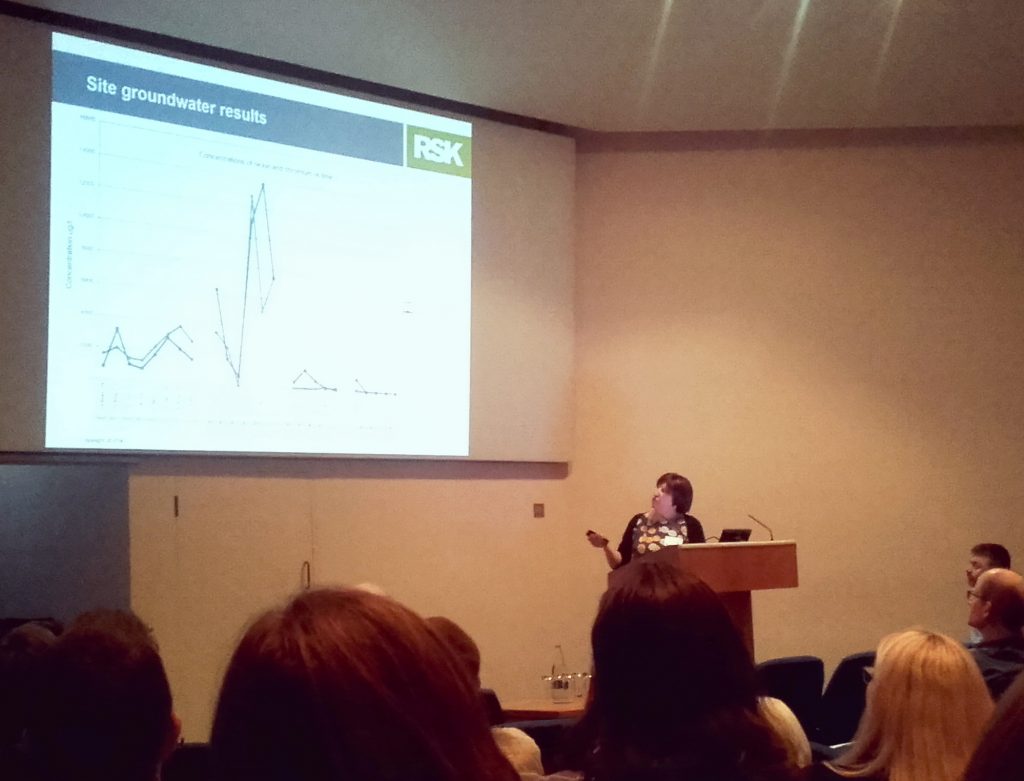
Full Name: Vivien Dent BSc MSc CGeol FGS ASoBRA Controlled Waters
Job Title: Associate Technical Director
Company: RSK
In 1994, I obtained a 2:1 Honours degree in geology from RHBNC subsequently obtaining an MSc in Hydrogeology from the University of East Anglia. My first job was working for Soil Mechanics as an assistant Geologist and then as a hydrogeologist at STATS. In 2008, STATS were brought by RSK, which is where I am to this day.
I am currently based in Boxworth where I am Team Leader. I get involved in a wide variety of geoenvironmental projects and I provide technical support to RSK’s geosciences teams on controlled waters and NAPL risk assessment and am the technical lead for sustainability in land condition.
I am also the current AGS Contaminated Land Working Group Leader.
What or who inspired you to join the geotechnical industry?
I have always loved geology and from the age of 8 (when my Grandfather gave me his fossil collection), I knew I wanted to be a geologist.
What does a typical day entail?
I don’t think there is such a thing as a typical day – which is partly why I like my job. I generally work 3 days in the office and one day at home. One day I could be in the office managing staff, tendering and writing reports, another day I could be delivering training at another RSK office.
Are there any projects which you’re particularly proud to have been a part of?
I wouldn’t say there is a particular job I am proud to have been a part of. I find all my projects interesting. No 2 sites are the same – the conceptual site model is always different, and each site has specific problems to address. I really like the varied nature of my work.
What are the most challenging aspects of your role?
The most challenging aspect of my role is juggling work life with having a family. RSK are very flexible allowing me to work part time and I work from both the office and from home. Now my children are getting older it is getting easier.
What AGS Working Group(s) are you a Member of and what are your current focuses?
I am a member and the current leader of the Contaminated Land Working Group. The group are working on a number of projects and my focus as Leader is to try and make sure that projects are progressed. Members do a lot of work in their own time and I’m always impressed with the effort that people put in.
What do you enjoy most about being an AGS Member?
The thing I enjoy most is meeting and getting to know new people from across the industry and the knowledge sharing.
What do you find beneficial about being an AGS Member?
The most beneficial thing is the knowledge sharing and knowing that everyone in the group wants to promote best practice and raise quality in the industry.
Why do you feel the AGS is important to the industry?
The AGS is important to industry as we can promote best practice. It gives people / the industry a voice where there is uncertainty.
What changes would you like to see implemented in the geotechnical industry?
The geotechnical industry is still very male dominated! I don’t believe that women should be recruited just to get the gender balance right – they should be recruited on merit. There are more women in the industry now than there were 20 years ago and a lot more is done now in schools to show girls what career opportunities there are – but I think there is still a long way to go.
This article was featured in the July/August 2018 issue of the AGS Magazine which can be viewed here.
SiLC Affiliate Scheme
- by
The SiLC Affiliant Scheme is due to be launched later this year to assist graduates and those who have already progressed beyond graduation to work towards SiLC Registration. A challenge for all professional bodies is to support individuals with the potential to become full members and bring them in at entry level membership. It is proposed that the SiLC Affiliate Scheme will create a potential pipeline of graduates and more experienced individuals working towards full membership and Chartered Status with their professional institutions, the latter being a pre-requisite for SiLC Registration.
Access to advice and mentoring for career progression through the SiLC Affiliate Scheme would :
• Encourage each individual to pursue professional qualifications and memberships;
• Encourage people to recognise the brownfield sector as a career path;
• Give mentored access to the Brownfield Skills Development Framework;
• Help Institutions build membership;
• Funnel graduates into Institutions and towards SiLC Registration in the longer term;
• Create greater momentum and growth in the SiLC Register and underpin the SiLC Register in the long term.
The proposal is set out below which shows the three tiers leading to SiLC Registration together with the connection between the SiLC Affiliate Scheme and the Brownfield Skills Development Framework and the level of support which can be offered at each tier. An applicant can join the scheme at any stage.
The applicant will have access to an Adviser as they work towards Chartership. Subsequently they would gain access to a Mentor as they work towards SiLC Registration beyond the point at which they attain their individual Chartership.
The roles of the Adviser and Mentor are considered to be distinct and undertaken by a different group at each stage. The roles are presented below along with an indication of the range of support to be offered.
| Role | Qualification | Support offered |
| Adviser | A qualified member of the host Professional Body or the Membership Development staff of the host Professional Body | The aim would be to provide guidance to the candidate on the requirements of gaining the professional qualification with their relevant Professional Organisation. The Adviser will be familiar with the requirements of the host Professional Organisation and how this fits into the SiLC programme but will not necessarily be a SiLC |
| Mentor | A current SiLC registered on the SiLC list of approved mentors. | The aim of the Mentor is to offer specific guidance on the requirements of becoming a SiLC beyond the attainment of the initial Chartership with the host Professional Organisation. The Mentor will not necessarily be from the same Professional Organisation as the applicant but will be professsionally qualified with one of the Professional Organisations by virtue of being a registered SiLC. |
Applicants would be expected to demonstrate the following :
• That they are graduate members (or the equivalent) of one of the qualifying Professional Organisations;
• Have a genuine interest in the brownfield land sector;
• Be aiming to become a full member of a qualifying Professional Organisation and to join the SiLC Register;
• Their commitment to the code of conduct of their host Professional Organisation and that of SiLC.
The annual membership cost of the SiLC Affiliate Scheme would be £50 plus VAT. This fee would include 20% discount on the attendance fee for the SiLC Annual Forum.
An announcement will be made by SiLC when the lists of Advisers and Mentors are complete and everything is ready for the scheme to be launched.
For further information on SiLC visit https://www.silc.org.uk/ or find SiLC on LinkedIn.
Article provided by Roger Clark, Chartered Engineer, SiLC of Marlowclark Consulting Limited
This article was featured in the July/August 2018 issue of the AGS Magazine which can be viewed here.
Introduction to LPA 66 – Overview and Review of the Construction Act Payment Provisions
- byPart II of the Housing Grants (Construction and Regeneration Act) 1996 sets out provisions to ensure that payments are made promptly throughout the supply chain and that disputes are resolved swiftly. The 1996 Act was amended by Part 8 of the Local Democracy, Economic Development and Construction Act 2009 to close loop holes within its provisions. The government undertook to review the effectiveness of the 2009 Act 5 years after it came into effect in October 2011. The results of the review are expected soon.
LPA 66 describes the provisions of the above acts, and how their requirements are intended to be implemented in practice. The key points covered are;
• the definition of construction contracts which are covered by the Act;
• the core provisions of the Acts, including the right to interim payments, the right to be informed about the amount due, disallowing pay when paid clauses, the right to suspend performance for non-payment;
• payment notices, the client must issue a payment notice within five days of the date for payment, even if no amount is due, or the supplier’s application for payment can be treated as if it is the payment notice;
• pay less notices, the payer must pay the notified sum unless he issues a pay less notice in the manner required by the Act; and
• implied mechanisms, if the contract fails to provide an adequate mechanism for determining the due date and the final date for payment then the Act will imply one.
It is anticipated that the government review will highlight the following issues;
• inflated interim applications, where the payee issues a payment notice there is a temptation to use an inflated value as there is no requirement for the notified sum to be a proper value; and
• the form and content of a valid payment notice, there has been much litigation over what constitutes a valid payment notice.
LPA 66 – Overview and Review of the Construction Act Payment Provisions can be downloaded here.
LPA prepared by Zita Mansi, Associate, BLM
Article prepared by David Hutchinson, AGS Honorary Member
This article was featured in the July/August 2018 issue of the AGS Magazine which can be viewed here.
Reservoirs – Where are the panel engineers?
- byThe Reservoirs Act 1975 was set up to provide a legal framework for the creation, operation and maintenance of large raised reservoirs with a capacity in excess of 25,000 m3 above the lowest level of the downstream land (soon to be reduced to 10,000 m³). The Act and its associated Statutory Instruments provide a legal and administrative framework for the construction and management of reservoirs in a manner which reduces to an acceptable level the risks associated with the escapes of water from reservoirs. The preamble to the Act gives a legal statement of the objectives of the Act as to make further provision against the escapes of water from large reservoirs but in simple terms, this has been taken to be a requirement to ensure that the dam and reservoir are as safe (against an escape of water) as reasonably possibly for the persons and property downstream within reasonable economic considerations.
A key element of the Act is the requirement that the design, construction and management of large raised reservoirs must be under the direction of qualified civil engineers who have been peer reviewed as having appropriate levels of qualification and expertise. The Act requires these engineers to be on various panels, managed by DEFRA/EA, with different panels for strictly defined types of reservoirs (impounding/non impounding/service) and levels of expertise for varying duties.
The creation of a reservoir requires a panel engineer (the Construction Engineer) who is appointed to oversee the reservoir creation, to issue certificates at specific milestones during construction and remain responsible during the first filling and the early stages of use for between three to five years after the initial certification.
Subsequently, all existing reservoirs are required to be under the continual supervision of a Supervising Engineer; must be inspected by a higher level of panel engineer at a frequency not exceeding ten years or more frequently after construction in some instances; must have certain works carried out under the control of such engineers; information and monitoring records must be maintained at specified frequencies in certain formats; and works recommended in the interests of safety, (ie against the escape of water) must be carried out within certain timescales. There are also requirements if the reservoir is to be raised, abandoned, discontinued or if major works are to be carried out. The duties are carried out by various levels of panel engineer depending on whether the reservoir is impounding surface flows, non-impounding or a service reservoir, although in recent years, the latter two levels of panel engineer have essentially withered and the majority of experienced engineers are now on the All Reservoirs Panel who can carry out works for any reservoir. There is also a panel of generally younger engineers (the Supervising Panel) who have less experience and expertise but are able to carry out the generally annual, essentially visual, visits to the reservoir to observe and report on any changes.
The Act has operated well but the number of panel engineers has dropped substantially over the last 20 years or so and is now threatening to be inadequate for the operation of the Act as intended. There are also concerns about the adequacy of the experience of some of the recent appointees. An applicant to any of the panels is required to demonstrate their capability and experience and is generally interviewed by a panel of their peers who are already on the relevant or higher panel. Areas of inadequacies of knowledge and expertise are probed and a recommendation made as to whether the applicant is considered suitable or not. If a rejection is recommended, comments are usually given as to the perceived weaknesses and areas of inadequate expertise. Applicants are then required to address these issues and encouraged to reapply after a year or two.
Reservoir engineering depends substantially on a “feel” for the subject as much as strict engineering knowledge. It relies on an ability to consider and apply the interacting disciplines of geotechnical, hydrogeological, hydrological, hydraulic and environmental engineering in addition to the impacts of vegetation, animals and climate. Consequently, this knowledge and expertise can only be acquired by sufficient training and experience. This has become increasingly difficult in recent years with the tendency for design and construct contracts to be used, lack of site experience both in the UK and overseas and cost cutting within the industry. There has also been the introduction of separate and varying legislation for Wales and Scotland to complicate the situation and the creeping effects of ever increasing bureaucracy. Additionally, applicants previously had to be fellows of the ICE and to have had relevant design and site supervision experience. This has not been maintained and has widened the pool of applicants, but this has resulted in a reduction in the levels of experience and expertise in some instances.
The average age of the panel engineers has also increased with time with many having retired in the last few years and numerous others similarly due to leave the panels in the near future. This has resulted in the numbers on the All Reservoirs Panel falling by about 25% to about 30 in the last four years and by a somewhat greater amount from the formation of the panels in the mid 1980s when reservoir legislation was significantly amended by the 1975 Act. The reduction in the Supervising Panel has been more alarming with a reduction to a current level of about 150 engineers from three times this number in the mid 1980s. Concurrently, there has been a steady increase in reservoir numbers within the Act as numerous flood, amenity, farming and environmental reservoir schemes have been created.
Thus there is a looming problem of inadequate numbers of qualified engineers to carry out the required duties, and this will also impact on the training of future potential applicants to the panels. There is now little opportunity for UK engineers to gain experience of site work and to work on the larger, typically major water supply, schemes. No such large schemes have been built in the UK for several decades whilst overseas work is now typically staffed by local engineers. There also appears to be an issue that many of the younger engineers do not have the breadth of broad education and engineering experience or the appreciation of the complex issues involved for reservoir creation. The appreciation that reservoir creation is an evolving design and construction process, as are most projects involving a substantial geotechnical element, appears to be less accepted these days. Similarly, there have always been some panel engineers who have not always adequately considered the geotechnical issues sufficiently, together with the impacts of the relevant bio-engineering, vegetational and animal issues and this blinkered approach now seems to be more prevalent.
The opinion of the AGS is that there is a looming problem with the future numbers and quality of people on the various panels of engineers. With fewer experienced panel engineers, more reservoirs to be managed, the deterioration of dams under the effects of age and lack of maintenance, and the impacts of climate change and human activity, reservoir safety is likely to be compromised in the future. Action is required to improve the training and guidance for the younger engineers who are ultimately aspiring to All Reservoir Panel status.
A joint letter regarding the declining numbers of Panel Engineers was sent from the AGS and BDS to Professor Lord Robert Mair, President of the Institution of Civil Engineers and Professor David Balmforth Chair of the ICE Reservoirs Committee. The letter can be viewed here. A response to the letter from Professor David Balmforth Chair of the ICE Reservoirs Committee has been received and can be viewed here.
Article prepared by Chris Hoskins, AGS Honorary Member and reviewed by the AGS Loss Prevention Working Group.
This article was featured in the July/August 2018 issue of the AGS Magazine which can be viewed here.
AGS Senate: June 2018 Meeting Update
- byThe Senate, which meets four times a year, is made up of the current Officers, Working Group Leaders and elected representatives of the AGS. The duties of the Senate are to represent the entire membership of the AGS throughout the wider industry and to ensure that the AGS fulfils its purpose, including its legal and financial obligations. The Senate arranges the appointment of AGS representatives and approves various items of business (such as the Business Plan and proposed expenditure).
The Senate meeting held on 28th June 2018 in London followed a standard format to deal with AGS business and Neil Parry, the AGS Chair has provided an update on the items discussed. A significant number of items are discussed in Senate. During this meeting the topics included:
• The success of Members’ Day and the decision to hold next year’s meeting at the same venue.
• The planning of this year’s Ground Risk Conference on 12th September.
• The sending of a joint letter with the BDS to the President of the ICE regarding the shortage of Reservoir Panel Engineers.
Each of the Working Groups presented their reports to the Senate Members for comment. This ensures each of the groups can work together on various issues and prevents duplication. It is important that the groups provide a useful service to the AGS membership and their output is subject to the correct level of scrutiny.
Other items covered in the Senate meeting, which are usually on the agenda, included the Chairman’s Report, Financial Review, Membership, Meetings Programme, Strategy, forthcoming/new AGS Guides (such as the recently published AGS Guide to The Selection of Geotechnical Soil Laboratory Testing), representation on BSI and working together with other organisations.
Election to the AGS Senate, in addition to the Officers and Working Group Leaders is open to Practitioners, Affiliates, Graduate Members and Student Members. Voting is held for a number of these posts each year at the Annual General Meeting.
This article was featured in the July/August 2018 issue of the AGS Magazine which can be viewed here.
AGS Laboratories Working Group: July 2018 Meeting Update
- byThe third AGS Laboratories Working Group meeting of 2018 took place on 12th July 2018 at Geotechnica and the Laboratories Leader, Dimitris Xirouchakis of Structural Soils, has provided an update on the top three current issues the Laboratories Working Group are discussing.
Educating clients about geotechnical testing requirements, primarily, and less so about geoenvironmental testing
This issue impacts on testing quality and consequently, data quality. For instance, it was mentioned in the last meeting that geoenvironmental laboratories used to have many problems with unsuitable sample containers or sampling conditions. The UKAS requirement to report such samples as deviating has decreased the number of unsuitable samples submitted for analysis. The Laboratories Working Group are looking to contribute with a short article in the AGS Magazine on this topic.
Data quality at large; participation in Proficiency Testing and training of technicians
Clearly, samples that do not conform to testing standards are responsible for project delays, may yield low-quality results, and may create legal problems in the future. Laboratory accreditation is important as is the requirement for the labs to produce high-quality data, consistently. Participation in proficiency testing ensures that the laboratories perform testing under statistically controlled conditions.
AGS should continue educating members and non-members, especially university graduates and junior practitioners, by publishing guides and asking members to give presentations to universities or public forums. The AGS should continue to press for laboratory accreditation and high data quality.
Keeping members updated on standard development
The AGS will continue to keep Members updated on standard development.
The Laboratories Working Group are looking to increase participation, as many AGS Members have laboratories, these companies are encouraged to join the Laboratories Working Group. If you wish to attend AGS Laboratories Working Group meetings, please contact the AGS Secretariat by emailing ags@ags.org.uk.
This article was featured in the July/August 2018 issue of the AGS Magazine which can be viewed here.
Engineering in Chalk 2018
- byThe British Geotechnical Association (BGA) with support from the Engineering Group of the Geological Society (EGGS) will be hosting a major two-day international conference on Engineering in Chalk on 17th and 18th September 2018 at Imperial College in London.
The conference aims to bring together the knowledge and experience of industry and academia by presenting research and case histories to provide a definitive up to date perspective on engineering in Chalk.
Visit the event website for more information. To register for tickets, please click here.
Geotechnica 2018
- by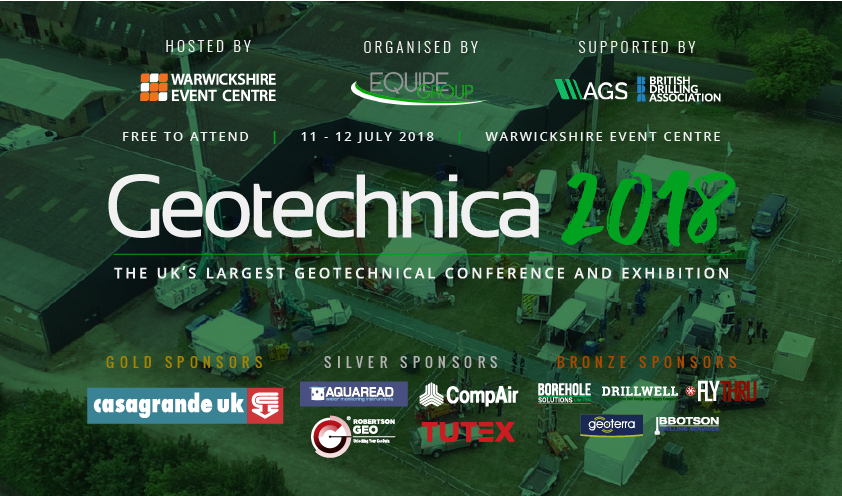
The UK’s largest geotechnical conference and exhibition is expecting unprecedented contractor attendance in 2018. With major upcoming infrastructure projects being discussed at this year’s conference, geotechnical contractors are likely to be flocking to Geotechnica 2018.
The team behind Geotechnica 2018 have now revealed the full talk titles from their speakers, as well as a breakdown of each talk’s synopsis. Held on the 11th and 12th July 2018 at the Warwickshire Event Centre, this year’s conference talks will centre around two key themes: Upcoming large UK infrastructure projects; and future leaders within the geotechnical industry.
This year the conference will discuss projects whose ground investigation contracts will form the backbone of the industry for years to come, whilst also giving a platform to younger engineers to discuss fresh ideas, new approaches and areas of concern for the ever-expanding and evolving geotechnical industry. Full synopsis and talk titles can now be found on the event website: www.geotechnica.co.uk.
Speakers include: HS2’s Head of Geotechnics, Nick Sartain; Associate Director at Arup, Jane Collins; iSMART Project member, Dr Tom Dijkstra; 2017’s Cooling Prize Winner, Arup’s Fransesc Mirada; and Aecom’s Ground Engineering Rising Star Award candidate, Giannis Kallika.
“This year, Geotechnica will offer a truly unique opportunity for attendees to hear from individuals representing organisations involved in some of the UK’s more significant infrastructure projects. We are aiming for the conference to take a glimpse into the future and look at some of the challenges involved in these projects as they relate to ground engineering and some of the solutions we as an industry can and should be able to offer.” says Calum Spires, Head Organiser of the Geotechnica event.
“These talks will be a chance for geotechnical contractors and consultants to hear directly from those responsible for the continuing development of large UK-based infrastructure projects. This, coupled with the prospect of engaging with talented and acclaimed young engineers who are likely to be heading up these large projects in the future, means that Geotechnica is a must-attend event for the UK’s geotechnical contractors.”
Geotechnica 2018 will also feature a full product and service exhibition. A number of companies will be debuting new products, services and rigs, including Gold Sponsors for the 2018 event – Casagrande UK, and Dando Drilling International who will be launching their new cable percussion rig, the Dando Duke.
There will also be two AGS Working Group meetings taking place at the event, with the AGS Contaminated Land WG and AGS Laboratories WG both meeting on Thursday 12th July.
The event is entirely free to attend and Visitor Registration is now open at www.geotechnica.co.uk.
Porosity and permeability values: filling the gaps with NMR (Nuclear Magnetic Resonance)
- byBalazs Rigler of Fugro discusses the group’s efforts to improve the efficiency and accuracy of hydrological analyses for nearshore and onshore foundation engineering in soft geology.
The hydrological properties of sandy, chalk or clay geology are of interest to designers of foundations, tunnels and other underground structures. Without a robust understanding of porosity and permeability it is not possible to fully predict soil behaviour under different loading and groundwater regimes and it is harder to determine depth of weathering and risk of dissolution in chalk. But by the very nature of their diffusive relationship with water, these ground types present a range of physical and interpretative challenges in deriving accurate data on porosity, permeability and associated characteristics.
To date, engineers requiring porosity and permeability data have mostly relied on outputs from core analyses and packer testing techniques, which are limited by factors including core loss, low sample density, feasibility and cost. No single method has been effective in isolation, progress rates are slow and investigation of soft ground such as clays, is particularly problematic.
To address these challenges, Fugro is making significant progress with a downhole technique more usually associated with mining, and offshore oil and gas prospecting – Nuclear Magnetic Resonance (NMR).
A first important point to make is that NMR does not employ any radioactive source material, as its name might seem to suggest. Using the same principle applied in Magnetic Resonance Imaging (MRI) for medical scanning, NMR logging analyses the spin of hydrogen nuclei under the influence of magnetic forces.
Innovative
Though well-established in the oil and gas and mining sectors, NMR’s application for engineering and land geotechnical projects is quite innovative. Fugro has implemented the technology as part of its borehole geophysics offering because it can provide valuable hydrogeological insight for near-surface site characterisation projects.
The NMR technique effectively logs both porosity and permeability and can distinguish between mobile, capillary-bound and clay-bound water. It is effective in air, water or drilling mud and is less sensitive to variations in borehole conditions than other techniques.
The technique can be used in uncased or plastic/fibreglass cased holes (minimum = ~75 mm) even when grouted, eliminating the risk of borehole collapse, which often prevents the deployment of methods reliant on a radioactive source, such as neutron porosity.
Crucially, the NMR technique samples the ground formation away from the borehole wall and, unlike conventional downhole methods, is unaffected by borehole fluid, borehole wall geometry, mud cake or drilling induced disturbance of the near borehole formation.
NMR is thus well-suited to a wide variety of ground conditions including soft superficial sediments, clays, carbonates (limestone and chalk), sandstone and other sedimentary rocks. The method can provide unique information in certain geologies where parameters derived from other downhole techniques could be fundamentally flawed due to borehole conditions, complexity of data processing and (sometimes empirical) interpretational procedures.
Though they are of most interest in terms of hydrological properties, sandy soils can be the most difficult to core and are often imperfectly recovered, hence NMR provides an immediate fix for this type of problem.
Lithology
In addition, parameters derived from NMR measurements are independent of variations in lithology and do not rely upon empirical or lithology specific ‘corrections’. This is an important advantage for designers needing accurate, robust and reliable data on the saturated water volume and hydraulic properties of the ground for the foundations of river bridges, tunnels and other structures.
Using NMR data, formation porosity variations can be accurately measured and there is great potential to estimate or derive hydraulic permeability to provide information. Porosity and permeability as engineering parameters are typically provided as a continuous wireline geophysical log, thus avoiding the need for guesswork or interpolation in the event of limited core recovery or low packer test sample density.
Clay volume of formation can also be determined with a high level of confidence with some support from natural gamma log data.
NMR measurements and deliverables can be summarised as:
■ Calculation of total water content
■ Porosity (if water saturated) independent of rock matrix
■ Pore space distribution
■ Distribution of clay bound/capillary bound/mobile water
■ Permeability/hydraulic conductivity
■ Moisture content in the unsaturated zone – dry density can be derived with support from gamma-gamma density logging
Transition
NMR’s transition to onshore geotechnical applications and smaller diameter boreholes has only been possible with the recent introduction of appropriate slim hole tools.
The downhole sensor characteristics can be optimised based upon borehole diameter and geology to investigate concentric shells around the borehole; this allows discrete evaluation of the ground outside the zone disturbed by drilling. The specific measured zone lies within a 200 mm to 400 mm diameter of the sensitive shell (see Fig 2).
NMR logging works in continuous or stationary mode and, unless very large diameter wash-outs are present, borehole conditions have no effect on the measurements. The presence of such wash-outs can easily be determined by standard caliper downhole measurements.
The set-up is relatively low cost and portable, with a very wide range of probe sizes. The typical tool diameter for slim hole operations is 60 mm and maximum logging depth is ~1500 metres.
With the plastic/fibreglass sleeve ensuring data can be successfully gathered from a borehole without risk of collapse, the technique is saving time and money for over-water work, particularly where extra boreholes and jack-up platform/vessel time may be needed to use conventional techniques.
NMR is the only method which provides direct and lithology-independent information about water, moisture content and permeability as a continuous log.
The lateral investigation depth of the method is based on the well-defined cylinder about the borehole, with a minimum and maximum diameter from the borehole axis as a function of the magnet and coil array geometry and frequency of B1. High frequency tools have better signal-to-noise ratios but are sensitive closer to the tool, while low frequency tools yield data further away from the borehole. Thus, tool selection can be designed in a way that the readings are not influenced by the fluid in the borehole, the mudcake or the strongly altered, disturbed formation close to the borehole.
This greatly facilitates the collection of guaranteed porosity data readings along the full length of the borehole, even in unstable geology.
Permeability and hydraulic data
NMR also provides time and cost advantages when it comes to capturing hydraulic permeability data.
There is a limit to the retrieval of permeability data using other types of discrete tests, often leading to the additional need for comparatively expensive pumping tests.
With conventional methods, unless transit is estimated, permeability will require additional in situ logging based on packer testing and/or injection testing which involves complicated hardware and heavy equipment. This type of test only takes point measurements, while NMR provides a continuous log the full length of the borehole. In order to capture permeability and hydraulic transit data, several distinct surveys will be necessary involving separate hardware assemblies. Through the use of different size probes and frequencies, NMR logging captures all required data using one set-up, to save time and cost.
Improvement in the accuracy of permeability data is a particular focus of Fugro’s advancements in the use of NMR for civil engineering.
Calculation of porosity is straightforward, derived by separating the water content of the target strata into bound (clay or capillary) and free/mobile water content.
Maximised value
With insightful early planning with the client and designers, value from NMR can be maximised by clever selection of complementary downhole investigation techniques to facilitate measurement of permeability and other required hydrogeological data.
In a recent Fugro project, an NMR approach afforded greater surety of data capture across the target strata (chalk) than would have been possible using traditional (neutron porosity) radioactive source based methods. As well as the clear HSE benefits, the method provided valuable and comprehensive hydrogeological data critical to facilitate a robust characterisation of risk to foundation design within the chalk.
Borehole CCTV or an optical televiewer, for example, are often chosen to assess water inflow into a borehole, and outflow via fractures and joints. As a minimum, both methods need clear water to be effective since image quality suffers in murky water – to achieve this is often a challenging and time consuming operation in soft sedimentary geology.
For a current bridge foundation project, Fugro has used NMR combined with an acoustic televiewer to overcome the problem of ‘milky’ water within the borehole due to chalk geology. Use of a conventional borehole CCTV system would have involved flushing out the cloudy water and leaving the borehole to stand for anything between 24 and 72 hours to achieve the right conditions for optical inspection. This approach would mean taking two or three extra days of jack-up time per borehole and would also increase the risk of borehole collapse and associated requirement for redrilling operations. Both factors would result in a significant increase in cost and time required for the site characterisation programme.
Conclusion
Current advances in downhole NMR are especially exciting for near surface investigations for infrastructure development.
As discussed, the technique is effective whatever the water volume of the ground formation in the saturated zone, or whether its representation is clay bound, capillary bound or mobile water. NMR offers the potential to derive accurate, robust and reliable data on porosity and its relationship with permeability in order to provide information directly related to engineering properties and other important values.
With further work and evaluation, Fugro anticipates it could contribute much to characterise chalk and engineering properties wholly based on porosity, water content, clay content, acoustic and gamma density data.
As well as being of value for foundation design and tunnelling, the NMR method also offers potential for other applications such as water abstraction, flood alleviation schemes, grain size distribution, pit slope stability, open and closed fracture identification, tailings dams, mining and environmental investigations.
But technical progress like this, enhancing the site investigation (SI) industry’s capability to clarify risk for developers with benefits for programme efficiency, needs early collaboration to fully realise the benefits.
The expansion and upgrade of modern infrastructure, from city to coast, does not enjoy geographical and geological freedom; invariably its location will interact with less than ideal ground, complicated by historical use or adjacent development. Yet insufficient SI continues to rank as a major contributing factor to civil engineering and construction project overruns.
Risk and cost management in infrastructure development relies fundamentally on a robust, integrated and well planned SI and its power to create a fully evolved ground model specific to the development site. Only with this can ground risk be confidently characterised, taking full advantage of advanced and cutting edge methods such as NMR, in order to safely and successfully realise vital infrastructure development in challenging places.
Balazs Rigler is a wireline services manager at Fugro. This article was featured in the May/June issue of the AGS Magazine, which can be viewed here.
Images:
Fig 1: An example of logging equipment for NMR (Vista Clara)
Fig 2: Schematic drawing of the sensitivity zone (red shell) of a NMR sonde. [Walsh 2013]
Fig 3. Example NMR dataset with thin sandy strings in low permeability material
Data from NMR logging in an environment dominated by silts and clayey silts, but with some thin sand stringers. Note the large detected increase in the amount of mobile (large pore) water at ~9 metres. Below 9 metres there is a small but substantial fraction of mobile water which likely reflects the presence of very thin sand lens of the order of cm.
Fig 4. Example of NMR data from chalk (in the UK)
Fig 5 Example NMR data from London Clay and soft sediments in London
Data were acquired in East London and composite logs were made to compare results with spectral gamma and formation electrical conductivity logs. Logs demonstrate strong correlation and significant anomalies in gamma, water content, porosity and pore size distribution logs at shallow interval in the London Clay.
Q&A with Lynne Llewellyn
- byLynne Llewellyn BSc (Hons) CGeol FGS
National Technical Manager, Structural Soils Ltd
I have over 15 years experience working within the ground investigation industry, much of which has been gained with various contracting and consulting firms primarily as a geotechnical engineer. I currently work for Structural Soils Ltd (an RSK company) employed as their National Technical Manager. My experience gained within the industry has been wide and varied, beginning as a lab technician and culminating in my present role of overseeing all technical aspects of ground engineering for Structural Soils Ltd.
What or who inspired you to join the geotechnical industry?
I first became interested in Geology whilst doing my A-Levels. My teacher at this time was very enthusiastic about Geology which made an impression on me (and of course, I quite liked the prospect of field trips abroad). From A-Levels, I went on to study Geology at Cardiff University. Initially finding employment as a Geologist proved quite difficult as no one was prepared to employ me with no work experience, so I began my career as a laboratory technician on minimum wage. In retrospect, I am glad I did this as it provided me with a good grounding and understanding of the geotechnical testing side of the industry. I then became a site engineer (invaluable experience) for some years. As time progressed, I became involved in larger schemes gaining valuable experience from the many varied roles required from me by my employers. During my working career I have been inspired by many dedicated hardworking professionals within the industry who continuously strive to improve quality and actively encourage improvement and innovation.
What does a typical day entail?
As National Technical Manager at Structural Soils Ltd my role is varied and can differ from one day to the next. My main role is to assist the Technical Engineering Director to oversee, co-ordinate and implement the technical output of the company nationally. Therefore my working day can be filled with anything from training and mentoring staff to designing and implementing changes in procedures. Another day I can be giving tendering advice or reporting on a ground investigation. I also work closely with other technical specialists within the RSK group.
Are there any projects which you’re particularly proud to have been a part of?
Recently Structural Soils were asked to help the BBC DIY SOS Team who had a project in Swansea for the ‘The Roots Foundation’, a charity who provides support for young adults in care or leaving care. They successfully applied to the BBC’s Children In Need fund and the BBC DIY SOS granted their wish for a new property worth £1,000,000. The building they previously operated from was very small, dilapidated and not fit for purpose with the new build on the same site was potentially underlain by coal seams or workings.
Structural Soils Ltd gladly took up the challenge, without charge, to undertake 3 rotary ‘open hole’ boreholes to prove or disprove the presence of the coal seams and investigate the possibility of unrecorded old mine workings to satisfy Coal Authority requirements. I was part of the Structural Soils team who oversaw the drilling operations and all for such a worthwhile cause.
What are the most challenging aspects of your role?
Every day is a new challenge that is why I love being part of the geotechnical industry, no two projects or days are the same and therefore the challenges keep coming which is what makes me get out of bed in the morning.
What AGS Working Group(s) are you a Member of and what are your current focuses?
I have been a member of the Senate Committee since 2014 and am also the AGS’s representative on the BSi 526/Geotechnics Committee. As a member of the senate, I recently formed part of a task group set by the committee to update the ‘AGS Guide to Geotechnical Testing’ as this document had not been updated since 1998. I have also helped to review documents for the Loss Prevention Guidance document issued in 2017.
The BSi 526/Geotechnics Committee is responsible for planning, programming and coordinating standards in the area of geotechnics and on this committee I represent the AGS. The committee also provides UK input to CEN/TC 250/SC 7 Eurocode 7 Geotechnical design, Eurocodes related documents and mirrors the CEN/TC 288 Execution of Special Geotechnical Works. I ensure that the AGS has a voice on this committee and report developments back to the Senate.
What do you enjoy most about being an AGS Member?
Being a member of the AGS is rewarding as it puts you in touch with the industry in which you work in everyday allowing new perspectives and ideas to grow. At the AGS I enjoy the fact that new friendships are formed with likeminded individuals from different sectors within the industry.
What do you find beneficial about being an AGS Member?
Being an AGS member is beneficial for me as an individual as it assists with my own continuous professional development. In turn, I can help promote the AGS within the industry to ensure the latest industry standards, guidance and perspectives are being considered. The goal is for the individual AGS members to give this advice to our own organisations and in turn the Clients we undertake work for driving the industry forward.
Why do you feel the AGS is important to the industry?
The AGS with so many member companies within the industry is important as it brings together the professional and dedicated members of various firms with specialist knowledge of both geotechnical and geoenvironmental specialism’s giving them a platform for discussing industry standards and best practice. The AGS data format is also an invaluable part of the AGS work.
What changes would you like to see implemented in the geotechnical industry?
Within the AGS meetings and the wider industry there are always ‘hot’ topics regarding certain aspects of our work which we could change to improve technical output, quality including reducing H&S incidences. By being a member of the AGS I hope to continue to support these initiatives and spread the word.
This Q&A was featured in the May/June 2018 issue of the AGS Magazine, which can be viewed here.
